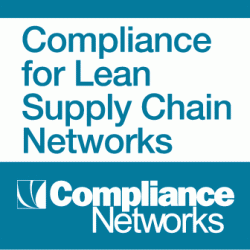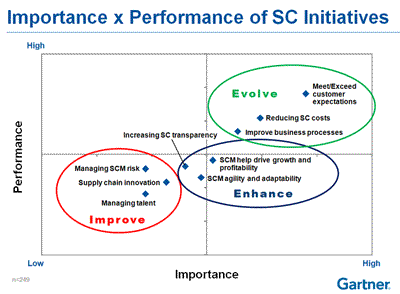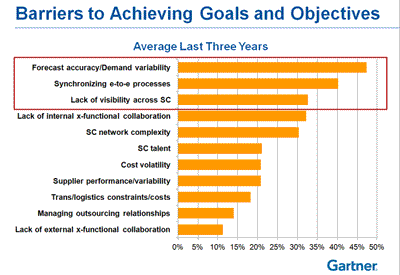 |
June 27, 2013 - Supply Chain Newsletter |
 |
| FEATURED SPONSOR: COMPLIANCE NETWORKS |
 |
The 13 Keys to Retail Vendor Performance, WebEDI, Visibility Means Cash, Retail Supply Chain Special Reports and more... |
 |
|
||||||||||||||||||||||||||||||||||||||||||||||||||||||||||||||
Insights from the 2013 Gartner Supply Chain StudyI am once again a bit late in summarizing the results of the annual Gartner-SCDigest study, but as usual it's good stuff and well worth taking a look at. This was the sixth consecutive year we have partnered with Gartner on this study, which keeps getting better and better, in part because we have six years of data to compare trends and changes over time. The 300 or so survey respondents are primarily SCDigest readers. The lead analysts at Gartner for the study were once again Dwight Klappich and Chad Eschinger.
A notable trend is that as the economy has moved from the depths of the recession when the annual study was launched to modest recovery, the top priorities for supply chain executives have evolved. Initially and not unexpectedly, cost reduction was the number 1 priority. As the economy started to recover in 2010, the top priority moved to increasing efficiency and productivity, which some might see as a proxy for cost cutting, but we believe had an important twist: companies were looking to get back to pre-recession volumes and activity without adding back all the supply chain head count and costs. The employment numbers suggest many were successful in achieving that goal. A lukewarm recovery has ensued over the past few years, which at least has led to a big drop in uncertainty even if demand has failed to rebound to levels usually seen following a deep recession. That has led the supply chain priorities to switched again. In the 2012 study, improved customer service moved to become the top priority. In this year's study, a focus on using the supply chain to drive business growth was number 1, with customer service moving back to the second spot. Reducing costs was still there at number 3, but we still think this priority switch from cost to service and growth is an important trend. In terms of expected priorities for 2015, the top three were (number 1) customer service, followed by business growth and (interestingly) third place "supply chain innovation." Cost cutting fell to number 6. Also (and quite surprising to me), "supporting Sustainability goals" was ranked 10th out of 10 this year, as in most past years and the 2015 predictions, though it manage a 7th place position last year. I like this chart in the report, which I believe is new this year. It uses a classic two-by-two matrix (which of course is the analyst's bread and butter tool), based on asking respondents about the importance and success across a number of common supply chain strategies and initiatives.
As can be seen, the sort of core/longstanding efforts around cost cutting and customer service ranked highest in both importance and performance. And indeed, the lower the level of importance, the lower the level of performance, naturally enough. I was only surprised by one thing here, and that was that managing supply chain risk scored so low in relative importance - risk management certainly seems high on the radar screens in many companies today. What are the barriers that get in the way of supply chain goal achievement? Gartner this year used an average of the past three year's results, and as with every other year of this study, forecast accuracy/demand variability came out on top, followed by number 2 inability to synchronize end-to-end processes, and third place a lack of supply chain visibility.
Interestingly, lack of trading partner collaboration came in last among the 11 choices provided in the survey. At this stage of supply chain evolution, I would have thought that would have ranked as a higher obstacle, as many companies feel that have about leaned and optimized out their own internal supply chains, and see the interfaces with trading partners as the next opportunity for real supply chain performance improvement. Klappich and Eschinger note that many of these obstacles are connected. "Take complexity, demand variability, lack of visibility and the inability to synchronize end-to-end processes - these are all linked at the hip," they say. Gartner itself is largely bullish on "the cloud" for supply chain software applications, saying that by 2016, more than 40% of new logistics application purchases will be delivered through the cloud. I personally believe the number will be higher than that. My view appears to be supported by the data, which shows respondents believe that by 2015, traditional "on-premise" deployments of supply chain software will only represent about 42% of the total. The data also shows that users believe that lower integration costs are a key perceived benefit of cloud-based software, but that users also perceive that cloud-based solutions often provide lower functionality. That may have been true even five years ago, but is certainly not true now, with virtually all supply chain software providers offering cloud solutions in one form or another today. Finally, the survey found an important discrepancy between the desire of companies for supply chain agility, and the flexibility of the supply chain software they currently have. This "agility gap" is large, with some 85% of respondents saying that flexible supply chain applications are critical, but only 42% saying their current software provides that flexibility. What to do about that? That isn't clear, other than noting that in this age of rapidly changing supply chain dynamics, companies should probably raise the flexibility to make needed changes higher up in the selection criteria weighting versus functionality differences that dominate selection processes today. There is a lot more, but that's all I have room for. You have to be a Gartner client to get the full report, but if you send me an email at the feedback button below I may just have a copy. Any reaction to this year's Gartner Supply Chain report highlights for 2013? Does supply chain software still need to be more flexible? Let us know your thoughts at the Feedback button below. |
|||||||||||||||||||||||||||||||||||||||||||||||||||||||||||||||
|
|||||||||||||||||||||||||||||||||||||||||||||||||||||||||||||||
|
|
|
YOUR FEEDBACK
Received a number of letters from our First Thoughts column last week on Supply Chain Future - A Physical Internet?
We publish a few of those below, including our Feedback of the Week from John Hill of St Onge, who provides some context on how the whole idea was started.
Feedback of the Week - The Physical Internet:
The roots for the PI initiative can be traced to MHI's 2007 Material Handling Logistics Summit and a proposal for concept refinement funding presented to MHI & CICMHE by Drs. Russ Meller and Benoit Montreuil (Universite Laval, Quebec) in 2010. An excerpt from the proposal: The 2007 Material Handling Logistics Summit was a defining moment for CICMHE, MHIA and all of the Summit participants. In fact, the foundation for the proposed research can be traced back to this event. One of the summary themes of the Summit was, Theme 4: Vision and roadmap for next-generation supply chains and associated Material Handling & Logistics innovation challenges, steering key projects. We present a proposal that directly addresses this theme and one of its associated initiatives, Develop a vision and models for future supply chains by exploring intra-facility and inter- facility issues, identify gaps in state-of-the-art and knowledge, and generate a research and development roadmap, perhaps through a think tank. As will be shown in our proposal, we have developed such a vision, proposed models related to this effort, and identified a group of industrial collaborators that will, along with the principal investigators and other researchers, seed the think tank. I offer this bit of information not only to recognize the early sponsors (MHI, CICMHE, CELDI) and pioneers (Ellis, Meller, Montreuil and those currently helping them), but also to assure that when the history of the Physical Internet is written (and it will be) that its origins are not obfuscated by faded memories. Along similar lines, keep an eye on what MHI and other organizations are doing in support of development of a US Roadmap for Material Handling & Logistics. Neither the PI nor the Roadmap will be a short term initiative, but it's good to see private industry and academia collaborating today on solutions that will enhance the contributions the supply chain community can bring to the quality of life for future generations. John Hill |
||
| More on Physical Internet: | ||
Your article on the Physical Internet syncs with a lot of activities going on this space under various names including internet of things, real-time supply chains,... So you were not late in your report. Good things happen in Nine months!! Amazon just announced their same day delivery of groceries. Walmart has been at it in some cities. A lot of technologies including RFID, GPS, OCR have come in waves and left varying experiences with the early adopters. It is the second wave now that is leveraging the lessons learnt with a more educated customer deploying tactical solutions with tangible benefits. The Quebec-to-LA example raises a lot of basic questions on the need to rethink the solutions and address new demands for how same-day-deliveries will be accomplished by supply chains. It is a great time for the American economy and innovators to rethink the value of every supply chain link. Subhash Chowdary |
||
I think this would work. Container modularization changed the world of shipping when standards were agreed, but it took a visionary like Malcolm McLean to take the risk, invest and lead change. In today's opinionated, open to anything environment, I think that human aspect of being able to agree to a standard will be the obstacle. After all, there plenty of technical solutions to most of the problems we face nowadays, reaching consensus is not just an issue in Washington. Of course, back to basics, as with a pallet, chassis or container, who will be responsible for the cost to replace the damaged modular unit? Eugene V. Nusekabel |
SUPPLY CHAIN TRIVIA ANSWER
Q: What is the best location to put a single US DC, based on overall population spread?
A: Vincennes, IN, southwest of Indianapolis, according to the annual analysis from Chicago Consulting group, based on lowest average lead times. That point is shifting West, from the Bloomington, IN area.
| © SupplyChainDigest™ 2003-2013. All Rights Reserved. SupplyChainDigest PO Box 714 Springboro, Ohio 45066 |
POWERED BY: XDIMENSION
|










